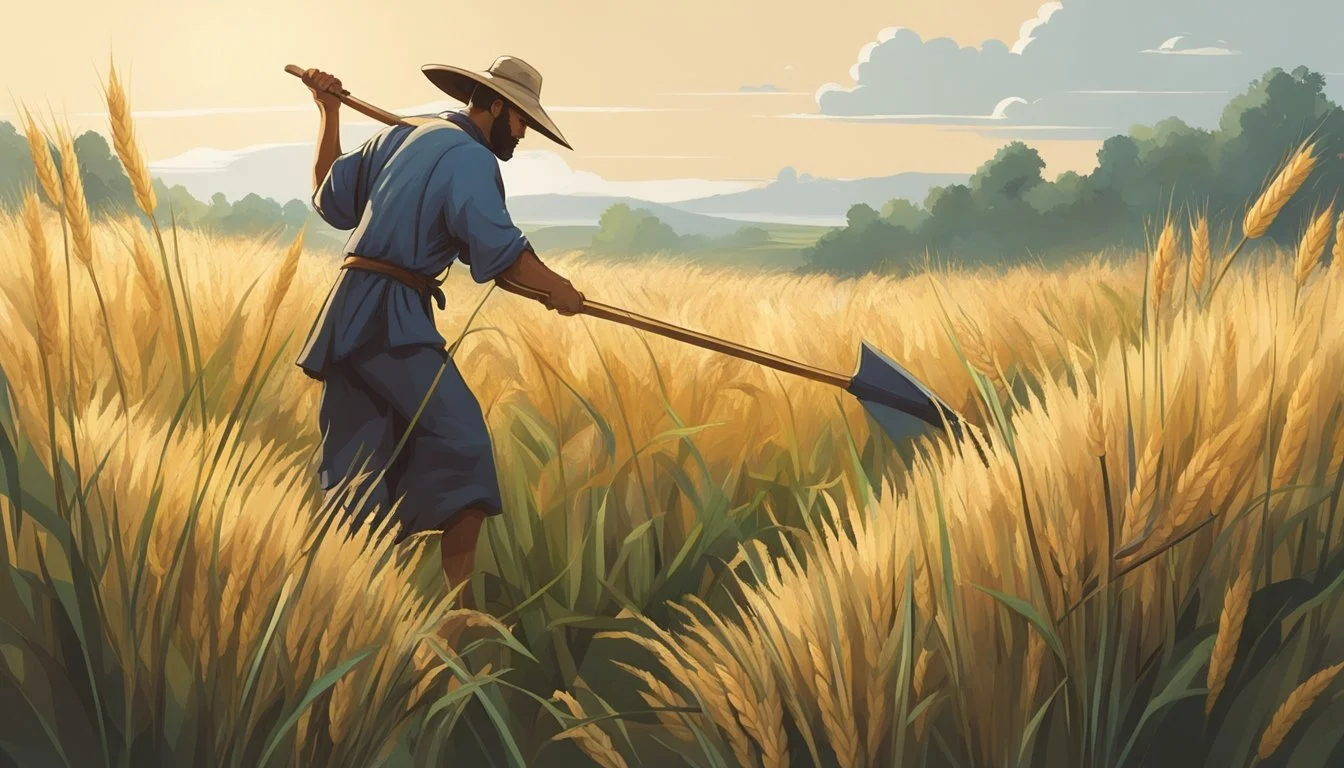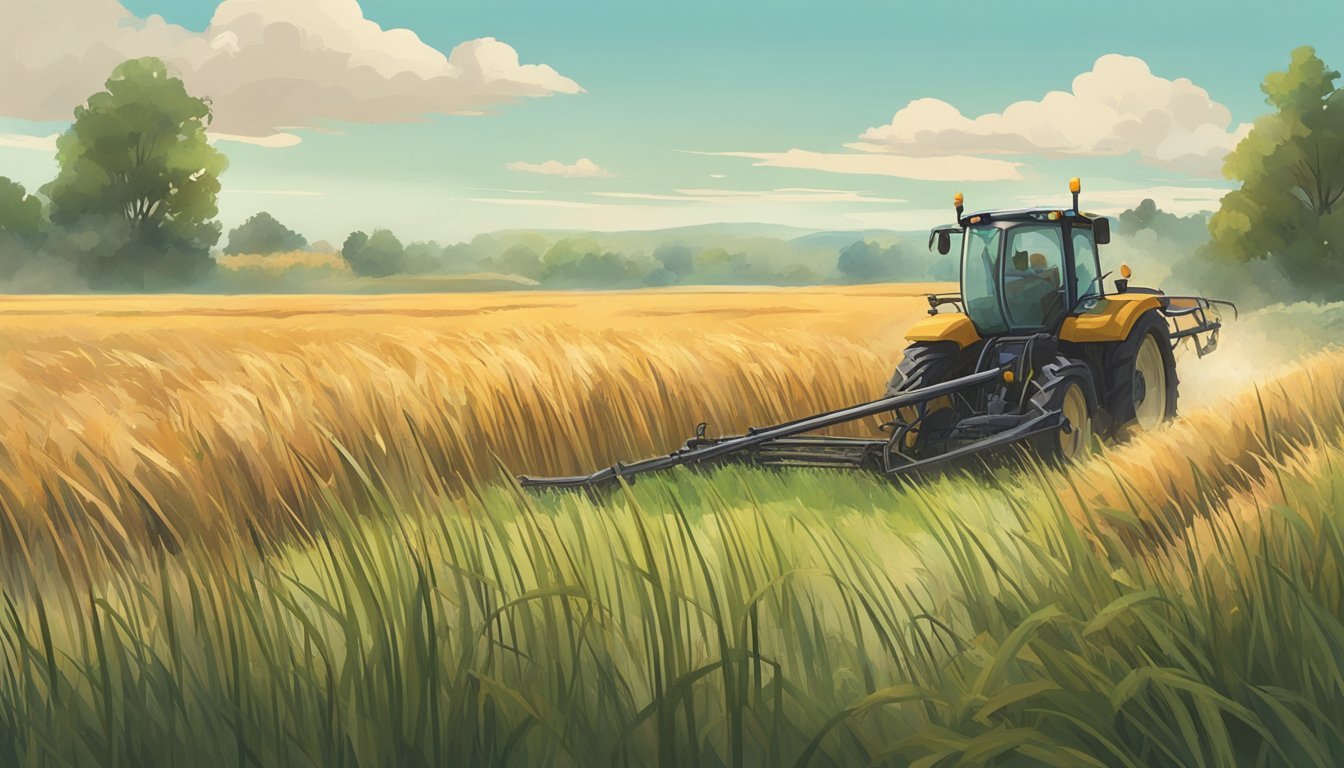Mastering the Scythe
Streamline Your Homestead Harvesting and Mowing Techniques
The resurgence of the scythe as a tool for mowing grass and harvesting crops comes as modern homesteaders seek more environmentally sustainable and physically engaging methods. A scythe, with its long curved blade and ergonomic handle, offers an efficient and clean-cutting alternative to gas-powered machinery. When used correctly, it can slice through grass and crops with precision, relying on human power to promote healthy ecosystems and reduce fossil fuel dependence.
Mastering the use of a scythe on the homestead requires maintaining a sharp blade and employing the proper technique. The art of scything isn't merely about strength; it is a rhythmic motion that combines form and finesse to achieve the best results. Honing the blade regularly with a whetstone ensures a consistent, clean cut, which is crucial for the health of the plants and the ease of the task.
To achieve efficiency, homesteaders must become familiar with the scythe's components, such as the snath, or handle, and the importance of customizing it to match their body's dimensions. Mowing with a scythe is not necessarily intuitive and takes practice. However, those who invest the effort to learn this age-old skill find it a rewarding and effective way to manage their land.
History and Evolution of the Scythe
The scythe has undergone significant changes from its ancient origins to its modern adaptations, influencing agriculture across various regions.
Ancient Tool to Modern Times
The scythe is an ancient agricultural tool that has played a crucial role in farming practices for centuries. Initially, the European scythe featured a large curved blade affixed at a right angle to a long wooden shaft, called a snath. This design allowed for a more ergonomic swinging motion, which was critical for mowing grass and reaping crops effectively and with less fatigue. Historically, scythes were the primary means of cutting down grains before the advent of threshing machinery.
With the Industrial Revolution's dawn, new technological advancements began to emerge. The American scythe, for instance, evolved with slight modifications to suit the conditions and harvesting methods of the New World. Tools were further refined for efficiency, leading to the development of mechanized reaping machines that ultimately supplanted manual scything in many areas, particularly in North America.
Geographical Variations
The scythe's design and usage have varied with geography, adapting to the local agricultural needs and techniques.
Europe: The European scythe features a lighter blade and an adjustable handle, providing precision and control for tasks such as cutting grain and grass. European scythes have consistently seen use, especially in areas where traditional farming methods are maintained and mechanical harvesting is less feasible or practical.
North America: In contrast, the American scythe incorporates design elements that cater to varied terrain and conditions encountered across the continent. North American scythes traditionally had a heavier, more robust blade and a slightly different snath design, aimed at tackling the tough grasses of the New World's landscapes.
Anatomy of the Scythe
The scythe is a sophisticated tool composed of several parts, each contributing to its efficiency in mowing grass and harvesting crops. Understanding the individual components and their roles is essential for mastering the use of a scythe.
Understanding the Scythe Components
A traditional scythe consists of two main parts: the snath and the blade. The snath is the handle that supports the blade and provides the structure a user holds onto. It's typically made of wood or metal with grips or handles along its length for comfortable use. The blade is a long, curved steel cutting implement that comes in various shapes and sizes, specifically designed for clean and efficient cutting.
Snath Design Variations
The snath can come in different forms to accommodate various body types and mowing conditions. Variations include straight, S-curved, or C-curved handle designs, which can affect the ergonomics and cutting motion. The presence and positioning of grips, including a curved handle, give users leverage and control when swinging the blade.
Blade Types and Their Uses
Scythe blades vary in length and curvature, each suited to particular tasks. A long, curved blade is typically used for cutting large swaths of grass efficiently. In contrast, a shorter, straighter blade may be used for more precise work around obstacles. The blade’s thickness can range from thin, suitable for light grasses, to thick for tackling tougher vegetation.
Managing the Attachment: Tang and Grips
The blade attaches to the snath with a hardware feature called a tang. Proper management of this connection is crucial as it ensures the blade's stability during use. The scythe's grips, including the main and auxiliary handles, are strategically positioned to offer control and minimize fatigue. They enable the user to maintain a firm hold and manipulate the blade effectively through various cutting motions.
Preparation and Maintenance
Proper preparation and regular maintenance are vital to ensure that your scythe remains an efficient tool for mowing grass and harvesting crops. A well-maintained scythe keeps its sharpness longer and reduces the physical effort needed during use.
The Art of Sharpening: Whetstones and Jigs
Whetstones are key tools for honing a scythe blade to maintain a sharp edge. It is important to regularly use a fine-grit whedstone, with the proper technique, to sharpen the blade. A sharpening jig can assist by holding the blade at the correct angle, thereby ensuring a consistent edge across the scythe.
Honing Steps:
Wet the whetstone with water or oil.
Hold the stone at a consistent angle of approximately 30 degrees to the scythe's edge.
Use smooth strokes along the blade's curvature, honing from the middle towards the edge.
Frequently check the edge for uniform sharpness.
Mastering the Peening Process
Peening is the process of thinning the scythe's blade edge with a peening hammer and anvil or a specialized peening jig, making it easier to sharpen effectively. This should be done periodically, depending on the blade's condition and the frequency of use.
Peening Steps:
Lightly hammer the blade edge along the anvil, carefully drawing out the metal.
Ensure symmetrical work across the blade to maintain balance.
Avoid over-peening, as it can weaken the metal.
Maintaining the Scythe: Routine Checks and Upkeep
A quality scythe requires consistent maintenance to operate at peak efficiency. This includes checking the blade for nicks, ensuring the snath (handle) is secure, and inspecting the hardware for wear or damage.
Maintenance Checklist:
Inspect the edge for sharpness before and after each use.
Tighten any loose screws or fastenings.
Clean the blade and apply a light coat of oil to prevent rust.
Store in a dry place to protect the blade and handle from moisture damage.
Techniques for Effective Mowing
Mastering the scythe requires understanding the mechanics of the proper stance and swing, adapting techniques to different terrains, and effectively handling various vegetation. These elements contribute to efficient and effective mowing on any homestead.
The Proper Stance and Swing
The efficiency of scything is greatly influenced by the mower's position and technique. One's stance should be stable and comfortable, with feet shoulder-width apart. The scythe is gripped with hands apart to maximize control during the swing. The motion originates from the torso, using it as a pivot point — the arms contribute by guiding the scythe’s path, but they should not bear the brunt of the work. A smooth, continuous motion that arcs from right to left for right-handed users, or left to right for left-handed users, clears a swath of grass with each pass.
Mowing Different Terrains
On flat land, a mower should maintain a consistent rhythm, keeping the blade's heel in slight contact with the ground. This ensures a clean cut without scalping the earth. On slopes or uneven ground, the mower must adjust their stance to maintain balance and control over the scythe, anchoring themselves firmly to accommodate the gradient. After rain, when the ground may be slippery, extra caution is needed to keep the correct position and prevent accidents.
Handling Various Vegetation: Grass, Weeds, and Light Brush
For fresh meadow grass, a sharp scythe swings through cleanly, making for easy work. Weeds and thicker vegetation such as light brush require a slightly different approach. The blade should be kept as sharp as possible, using a whetstone to hone the edge regularly. When facing tough weeds or brush, short, deliberate strokes with minimal ground resistance allow for a series of efficient cuts without getting stuck midway. It’s important to adjust the cutting technique according to the density of the vegetation to maintain efficiency.
Using the Scythe on the Homestead
Mastering the use of a scythe can enhance the efficiency and eco-friendliness of managing gardens, harvesting crops, and creating mulch on a homestead.
Managing Gardens and Lawns
A scythe is a versatile tool for grass cutting on homesteads. Rather than using fuel-intensive lawnmowers, one can use a scythe to maintain garden paths and lawn edges with precision. Regular mowing with a scythe can also discourage the growth of weeds, promoting a healthier garden ecosystem. Additionally, proper technique is essential for efficient cutting and to prevent muscle strain.
Harvesting Hay and Crops
Farmers have traditionally used scythes to harvest hay and crops due to their effectiveness and low cost. The scythe allows for the careful selection of ripe plants, minimizing damage and waste. In comparison to machine harvesting, using a scythe is quiet, does not compress the soil, and can be done with minimal disturbance to wildlife.
Relevant steps for harvesting hay with a scythe:
Sharpen the Blade: Ensure the scythe blade is sharp for clean cuts.
Sweeping Motion: Use a consistent, sweeping motion to lay the cut hay in a uniform direction.
Timing: Harvest early in the morning when the dew prevents dust and helps hay to stick together.
Creating Mulch for Permaculture Applications
The ability to create organic mulch for permaculture gardens is another benefit of using a scythe. Mulching with scythe-cut materials like tall grass can improve soil health and reduce water usage. Sheet mulching, an application where layers of organic material decompose to enrich the soil, can be facilitated by the scythe's ability to produce a variety of mulch materials efficiently.
Quick Tips for Mulching:
Cut grasses or cover crops before they seed.
Layer the cut material to a depth of about 6 inches to suppress weeds and retain soil moisture.
Using a scythe on the homestead for these applications not only helps maintain a productive and eco-friendly environment but also connects one to traditional farming practices.
Practical Considerations
When mastering the scythe, one must weigh environmental benefits, uphold safety standards, and anticipate challenges posed by dense vegetation.
Environmental Impact and Eco-Friendliness
The scythe stands out as a fuel-free tool, making it eco-friendly since it doesn’t any require gasoline or electricity, thereby reducing the homesteader’s carbon footprint. Those who use a scythe contribute positively to the environment by avoiding emissions typically associated with powered mowers.
Safety First: Best Practices and Common Injuries
Safety is paramount when handling a scythe. Proper technique can minimize risks such as lacerations or muscle strain. Homesteaders should:
Wear protective gloves and sturdy boots
Ensure the blade is sharply honed before use
Utilize smooth, controlled motions to prevent accidents
Take regular breaks to avoid fatigue-related injuries
Managing Challenges: Thick Brush and Undergrowth
In scenarios where homesteaders face thick brush or dense bushes, a well-maintained scythe proves effective. Key strategies include:
Shallow angles for slicing through dense growth efficiently
Regular sharpening to maintain optimal cutting performance
Tackling thick vegetation in layers if necessary to prevent the scythe from getting stuck
Additional Resources
For those seeking to refine their scything skills or to find the right tools, a wealth of resources is available. From expert-authored literature to online communities and suppliers, these resources provide comprehensive support for both novices and seasoned practitioners in the art of scything.
Books and Manuals
David Tresemer: He is the author of The Scythe Book, a highly regarded text which has been educating readers on mowing techniques and blade care.
Ian Miller: Known for his work, The Scything Handbook which is a modern guide for those wanting to learn how to cut grass, harvest crops efficiently, and maintain their scythe.
Online Tutorials and Forums
YouTube: A wide array of instructional videos are present, featuring various techniques and tips for scything.
Internet forums: Communities such as the Scythe Association of Britain & Ireland (SABI) or the International Scythe Network where enthusiasts and experts discuss techniques, maintenance, and other scything-related topics.
Where to Find Quality Scythe Supplies and Accessories
Scythe Supply: They offer high-quality scythes, blades, snaths, and maintenance equipment.
Local Hardware Stores: Often stock basic scything supplies, and staff may be able to help with finding special items or placing special orders.
Specialized Agricultural Stores: Can provide tailored options and might offer workshops for hands-on learning experiences.




